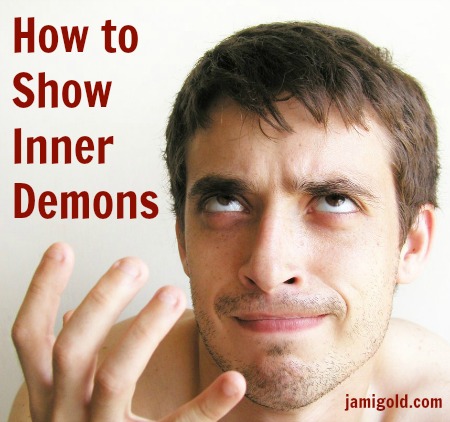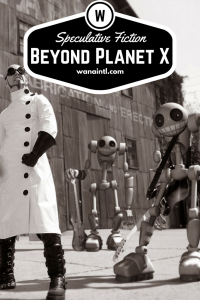Antagonists: Inner & Outer Demons — Guest: Kristen Lamb

As I mentioned last week, the next couple of weeks will be difficult for me health-wise, as I go through extra medical treatments in an attempt to salvage my rebuilt jawbone before my surgeon decides to rip out the last year of work due to instability. This week is especially kicking my butt, as I’m still fighting a cold too.
To lighten my load, with her permission, I’m sharing some of Kristen Lamb’s insights on antagonists: what they are, why they help define our story, how to strengthen them, etc.
Last week, we started by exploring what antagonists are, and specifically what a story’s main antagonist is, what she calls the Big Boss Troublemaker (BBT). As she mentioned in that post, antagonists aren’t always a person or a villain.
Sometimes, we’ll say that a character is their own worst enemy, such as the “man versus self” story premise. However, Kristen then pointed out how those stories still use proxies of the BBT to provide a face for the opposition.
Today, we’re going to talk more about how proxies push a character’s “man vs. self” struggle so our story isn’t just a character arguing with themselves. Kristen shares a great in-depth example by talking about the movie Black Swan.
If you haven’t seen the movie but want to fully understand the psychological aspects of the script and don’t mind spoilers, you can find the synopsis on IMDB here. Remember that with a mind-twisting story like this, there’s more than one way to interpret events, but Kristen’s point is to show how even in a story where our protagonist is also the antagonist, other outward antagonists represent the protagonist’s own issues.
Please welcome Kristen Lamb once again! *smile*
*****
Antagonist Proxies:
Black Swan–Inner & Outer Demons
For the past week, we have been talking about the antagonist. Whenever I blog about the antagonist, I always get, “Well, my character is the antagonist. She is her own worst enemy.”
As we discussed earlier, virtually all protagonists at the beginning of the story are their own worst enemies. That is called character arc.
If properly plotted, all protagonists would fail if pitted against their enemy in Act One. It is the story that makes our protagonists grow, mature and rise to become heroes and heroines.
Ah, but what if our protagonist literally is the antagonist?
This is when a proxy can be extremely helpful. Even fancy Hollywood directors know that. There will be a character who represents that side that must be conquered in order for the protagonist to be triumphant.
One of the best examples of this I have ever seen is the movie Black Swan. Spoiler alert if you choose to keep reading (will try to minimize spoiling the movie if you haven’t yet seen it).
Inner Demon Example: Black Swan Overview
In the movie Black Swan, the protagonist Nina is very literally at war with herself. She is a high-strung perfectionist who has clearly not been allowed to grow up like a normal young woman.
Nina is cast to take the place of an older dancer who is retiring (not so willingly). Nina must embrace the light and the dark, but can this good girl unleash the darkness pent inside, yet keep her sanity?
This is the big question presented in this psychological thriller.
For those not in the know, Swan Lake is basically a tragic fairy tale. A young girl is bound by a curse to become a swan forever, and true love is the only thing that can break the spell.
The cursed girl (Odette—the White Swan) finds hope in a young prince, but her evil twin sister (the Black Swan—Odile) seduces him away. Faced with defeat, Odette kills herself.
In the movie, Nina wins the role as the lead in Swan Lake and is perfect for the role of the delicate White Swan, Odette, but then progressively loses her mind as she becomes more like Odile, the Black Swan.
Inner Demons: Psychological Ideas
Nina does great with uptight, naïve innocence, and is perfect White Swan material. The problem is that Nina’s big life goal is to be perfect, but Nina needs to learn that true perfection is a mixture of order and chaos.
The Black Swan is a sexualized role. The Black Swan is a raw, visceral temptress. Nina can’t relate. She is too repressed by her overbearing mother who is living vicariously through her daughter.
Nina is her own worst enemy in that she is rigid and perfectionistic. That works for the White Swan, but the Black Swan—which she will also dance—must be more carefree and primal.
Outer Demons: How to Show “Ideas”
Ah, but here is where proxies come in handy, because a movie with Nina arguing with herself would be weird and probably boring. Aronofsky and the screenwriters came up with a brilliant solution which had me sitting on the edge of my seat all three times I watched the movie.
Their solution? Lily.
Mila Kunis plays Lily, Nina’s rival for the role of prima ballerina. Nina, coincidentally, has a rather intricate flower tattoo (black lilies) on her back that, in the right light, looks like a set of black folded wings.
Lily is everything that Nina longs to be. She is beautiful, wild, carefree, and doesn’t have some weirdo narcissist mother making her go to bed by 9.
“Own worst enemy” story? The hero must conquer a representation of their issues. Click To TweetIf Nina is her own worst enemy, how can we introduce her as a protagonist and an antagonist? We can’t. We need a proxy. We need Lily.
How does the director introduce Lily, yet still hint that the core antagonist is Nina? He uses a tad of camera trickery.
Nina is taking the subway into the city. She is wearing a pale pink coat and a white fluffy scarf, her hair up in a prim ballerina bun. Out of the corner of her eye, she spies what looks like her twin, only the “other Nina” is wearing a black coat and dark gray scarf (not so subtle symbol there).
Nina never sees her “twin’s” face, only sees that the girl has on iPod ear buds. In every way, though, this girl looks like the photo negative of Nina…her dark “other half.”
In the next scene, we are introduced to Lily and see she has on ear buds. This cues the viewing audience that Lily is the “twin” Nina spied on the subway. Lily is Nina’s “black swan.”
Lily is the main antagonist. Lily represents everything that Nina longs to be. She embodies the very essence that continues to elude Nina—raw sexuality.
Outer Demons: Proxies for Every Aspect
Yet, is Lily the only antagonist? Not by a long shot.
To really understand the other antagonists in this movie, we need to get to Nina’s core issue. What is Nina’s problem? She longs to grow up but she is afraid, namely because her overbearing mother does everything she can to keep her a “little girl.”
While the director Thomas is daring Nina to explore her sexuality and discover her wild side, Mom is busy buying Nina more stuffed ballerina bunnies for her pink little girl bedroom. Nina is being pulled against to polar extremes.
Repressed naïve little girl vs. wild sexual temptress.
Even though Nina is her own worst enemy, I challenge you to look at each of the scenes in this movie. There was almost always an outside antagonist driving her arc, exposing the soft and tender parts that Nina was trying so hard to cover.
She is a girl who needs to control and the thought of losing control terrifies her. But, to dance the Black Swan, that is exactly what she must do. She must be able to balance order and chaos. She must be able to keep control and lose control all in the same moment.
Can she?
- Thomas is pushing her to let loose. He even says, “The only person standing in your way is you.”
- Mom is doing everything in her power to force Nina to stay a “little girl.”
- Lily is showing Nina everything she could be…but isn’t.
The entire movie is a battle of two questions—Is Lily out to get Nina and take her part? Or, is Nina losing her mind?
The core question, however, is whether Nina can be both White Swan and Black Swan without fracturing. And that part I will leave out. This is an excellent movie and well worth studying.
Inner Demons: Depictions in Movies vs. Books
Suffice to say that movies have leeway that novelists do not. Nina is pitted toe-shoe to toe-shoe with her rival, Lily. This is where the camera work is very cool.
Every so often, we see Lily, but then there is a flash of Nina’s face…hinting that Nina is pitted against her own darkness that she has tried so hard to keep contained. A darkness, that, once let out of the box, has the power to destroy her.
What can we learn from this? If we can’t use the fancy camera trickery, then why bother studying this movie?
Study conflict and scene antagonists.
“Man vs. self” story? Create characters to represent the hero's internal debate. Click To TweetThomas and Mom represented the two sides warring for little Nina’s heart and mind. Lily was a brilliant proxy and made for a formidable BBT (Big Boss Troublemaker).
In the Big Boss Battle, Nina had to stand up to Lily (the Black Swan) and claim that she could dance both parts. According to narrative structure rules, Nina must utterly defeat/kill the BBT, which she does.
But who dies? Lily or Nina? Watch the movie. *smile*
As far as a book that explores inner demons, Dennis Lehane’s Shutter Island is one that I would highly recommend for study, and is a very similar psychological thriller. The book will give ways that you can have the protagonist as his own worst enemy, yet not reveal it.
*****
 Kristen Lamb is the author of the definitive guide to social media and branding for authors, Rise of the Machines—Human Authors in a Digital World. She’s also the author of #1 best-selling books We Are Not Alone—The Writer’s Guide to Social Media and Are You There, Blog? It’s Me, Writer.
Kristen Lamb is the author of the definitive guide to social media and branding for authors, Rise of the Machines—Human Authors in a Digital World. She’s also the author of #1 best-selling books We Are Not Alone—The Writer’s Guide to Social Media and Are You There, Blog? It’s Me, Writer.
Kristen has written over twelve hundred blogs and her site was recognized by Writer’s Digest Magazine as one of the Top 101 Websites for Writers. Her branding methods are responsible for selling millions of books and used by authors of every level, from emerging writers to mega authors.
*****
 Kristen is also the founder of the WANA (We Are Not Alone) movement, the owner and operator of WANA International, a company dedicated to educating authors of the Digital Age. She’s also the creator of WANATribe, the social network for creatives.
Kristen is also the founder of the WANA (We Are Not Alone) movement, the owner and operator of WANA International, a company dedicated to educating authors of the Digital Age. She’s also the creator of WANATribe, the social network for creatives.
WANA International is currently offering several writing-related classes, including one taught by Kristen: Beyond Planet X, Monsters & Chainsaws: Mastering Speculative Fiction
Find all current WANA International classes here!
*****
Thank you, Kristen! And as always, I can’t express my gratitude enough for your help during these few weeks!
I love how you point out that our story’s external antagonists can represent our protagonist’s inner demons. With that understanding, it’s easy (or at least easier) to know how to show our hero’s internal debate.
Conquering the antagonist then represents our hero conquering their issues. All without us resorting to showing our protagonist arguing with themselves for half the book. *smile*
Have you seen Black Swan? What did you think of the movie—did you like or dislike it? Does this example help explain how to create a story when our character is their own worst enemy? Can you think of other books or movies that we could study for a broader understanding?
Pin It
I’d appreciated the inner conflict Nina revealed in Black Swan, but did not fully grasp the role Lily played. Thanks to this insightful analysis, I want to see that movie again.
Jung is keen on this concept. Espoused in A Wizard of Earthsea when Ged has to turn and face the shadow that has been haunting him – the shadow of himself.
Jami, still pulling for you! Hoping you find days filled with joyful and surprising little moments to get you through the battle.
I’m big on Jung if for no other reason that my own personal struggles have manifested through predictable archetypes–in night dreams and in conscious goals and desires. Always one step ahead of cracking my allegorical self.
Anyway, Black Swan stole my material! I finally realized I needed two protagonists who began as each other’s Shadow (art imitating life). Another writing blog guru said I still have to PICK one for the main protagonist. What, spoil my own mystery?!
But done, and done. And these recent blogs of yours, Kristen, have shown how making such choices is crucial to bringing resolution to a plot.
Hi Gabriella,
Thanks for the good wishes! And I’m so glad to bring Kristen’s antagonist posts here. 🙂
I heard her take on antagonists years ago, and it stuck with me because she does such a great job of digging into them. I’m glad they’re helping! 😀
[…] Inner and Outer Demons […]